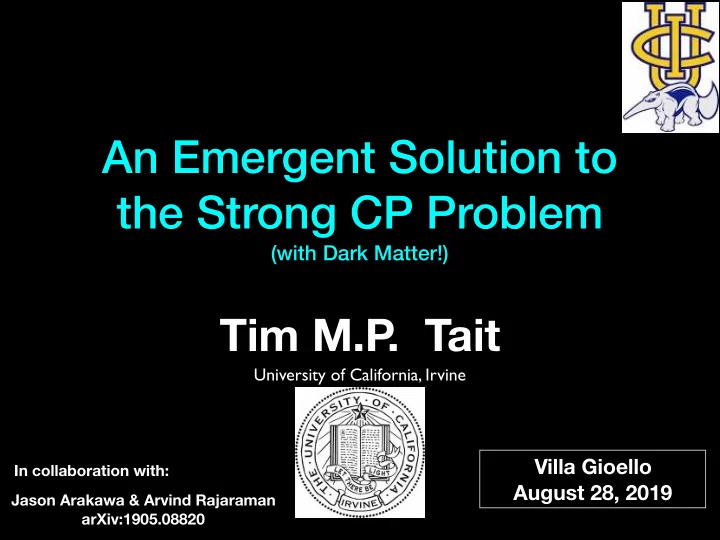

An Emergent Solution to the Strong CP Problem (with Dark Matter!) Tim M.P . Tait University of California, Irvine Villa Gioello In collaboration with: August 28, 2019 Jason Arakawa & Arvind Rajaraman arXiv:1905.08820
Could Dark Matter be the Solution to the Strong CP Problem? 10 -16 Natural Range from QCD
Could Dark Matter be the Solution to the Strong CP Problem? Yes, Axion: duce a potential w � � a ( x ) − Λ 4 cos a e a/f a − θ , G µ ν G a µ ν . f a for a which e ff ectiv
An Emergent Solution? • I’d like to explore a di ff erent type of approach. • Rather than the usual particle physics approach of introducing new fields with new dynamics which modify the properties of the vacuum, I have in mind emergent physics from the non-vacuum state we live in. • This is kind of like a condensed matter solution to a problem. • In this case, I imagine that the dark matter spin cancels theta bar. There is no fundamental axion field, though there is a spin-wave excitation of the DM medium that is axion-like.
Dark Matter • Spin -1 ultra-light boson (more on that later…) • Couples to gluons: ons through operators of the form, 1 α s S µ νρ S µ νρ ( A α A α ) n G a σλ e G σλ a M (6+2 n ) 16 π ∗ NR Spin S µ νρ [ A ] ≡ F µ ν A ρ − F µ ρ A ν • Other operators involving spin could work. • M * ~ TeV (monojets)
Strong CP • The dark matter in the Galaxy feels a gravitational potential which tells it how to clump and how to move. It doesn’t care what the spin does. • It feels an additional potential from QCD: ons through operators of the form, A 2 � n ! S µ νρ S µ νρ � 1 α s S µ νρ S µ νρ ( A α A α ) n G a � Λ 4 cos σλ e G σλ � ✓ a M (6+2 n ) 16 π M (6+2 n ) ∗ ⇤ • This additional potential can be minimized by choosing the net polarization density of the field appropriately such that S 2 cancels theta bar. • The spin density S 2 is bounded by the number density n 2 .
1 s 2 m 2 A (4+2 n ) ⇢ (2+ n ) ⇢ (2+ n ) ! 2+2 n ⇠ s 2 m (2+2 n ) . � m . M (6+2 n ) M (6+2 n ) M (6+2 n ) ⇤ ⇤ ⇤ The presence of operators with lower n is not problematic: they just don’t give a large enough contribution to cancel an O(1) theta bar.
Perturbations • We checked a bunch of things which could distort S, and thus spoil the solution of the strong CP problem. None look problematic. • Higher dimensional operators ( S µ νρ S µ νρ ) 2 � A λ A λ � p a p 1 e.g. p < n+5 16 ⇡ 2 M (8+2 p ) ⇤ • Dark matter magnetic dipole moment • DM Spin - Earth Spin gravitational interactions
Phenomenology • Dark matter can be produced via parametric resonance. • Below the fuzzy limit, constraints from e.g. the shapes of galaxies. • Structure formation is weird, because of QCD contributions to the vacuum energy which vary with position. (However, for n>6 and masses less than 10 -20 eV, nothing would have happened yet). • Gravitational wave detectors put limits on fifth force: Eot-Wash constrains the size of the DM coupling to the SM to be < 10 -23 in the mass range of interest. LISA will eventually improve limits for masses > 10 -18 eV. • CP may be strongly violated in DM poor regions of the Universe (outskirts of galaxies, globular clusters).
Open Questions • Locally varying contributions to the vacuum energy? • Tied up with a solution to the CC problem? • Structure formation? • Some kind of Quintessence? • Probes of distant CP violation? • What about the axion-like spin-wave state? • Are there other fundamental problems amenable to emergent solutions?
Thank You!
Recommend
More recommend